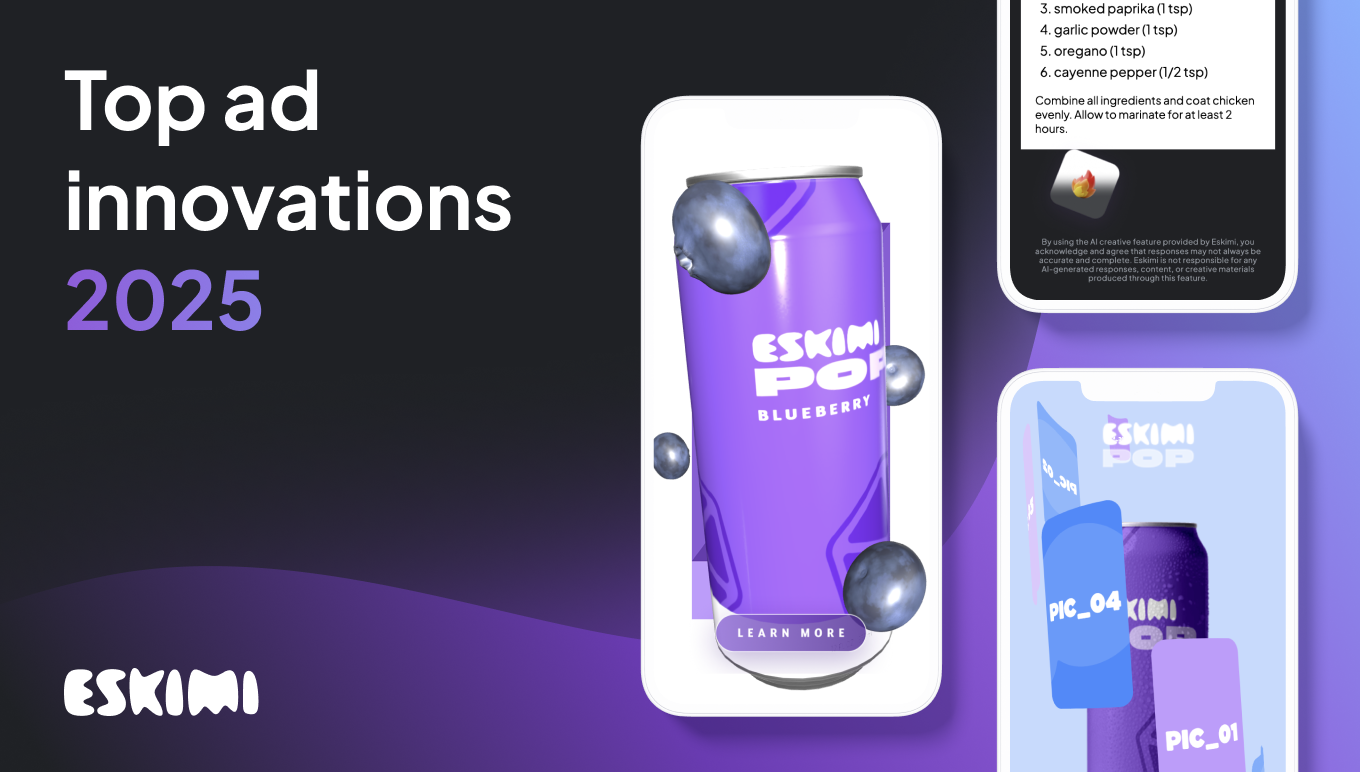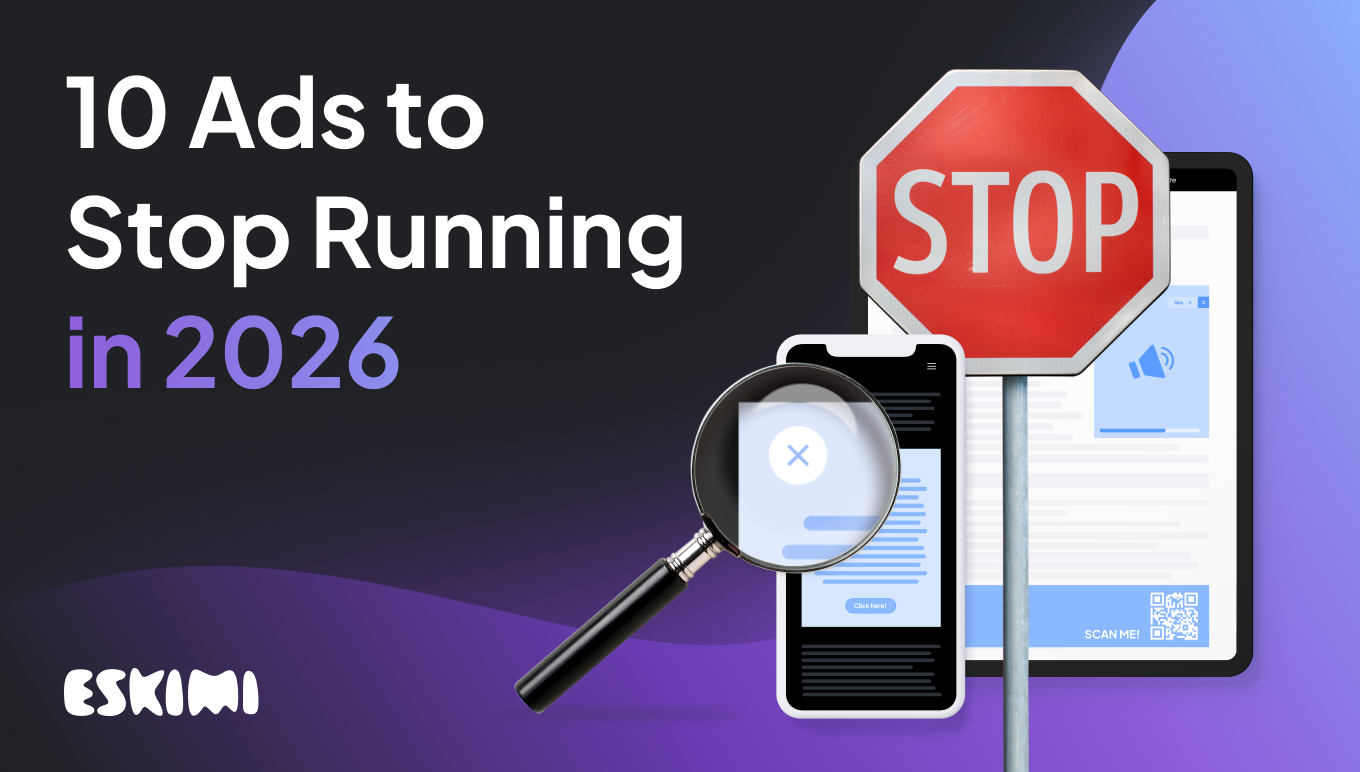Sustainable Advertising: Complete Ethical Marketer’s Guide

Ever considered the carbon footprint of your latest ad campaign? That can be as much as 5.4 metric tons of CO2 – surpassing the average annual emissions of one person. And putting a significant challenge within the advertising sector into the spotlight.
Today's eco-conscious consumers are no longer looking for products that work but for brands that care. In response, businesses are shifting towards sustainable advertising strategies that lessen their environmental impact and strengthen brand reputation and customer loyalty.
With a robust 60% of consumers willing to pay more for eco-friendly products and rigorous environmental regulations like the EU's Green Deal, the momentum for sustainable advertising is undeniable.
But what exactly does it mean to advertise sustainably? In this guide, we'll explore how sustainable advertising works, why it matters, and how forward-thinking brands are already making impactful changes.
What Is Sustainable Advertising?
Sustainable advertising is a marketing approach that integrates environmental responsibility and social values into the brand’s message.
Unlike traditional advertising, which often focuses solely on product promotion, sustainable advertising considers the entire lifecycle and impact of the campaign – from the resources used to the message delivered.
In practice, this involves:
- Choosing eco-friendly materials for print ads
- Minimizing energy consumption in digital campaigns
- Promoting products or services that are sustainable by design
In today’s market, where consumers increasingly base their purchasing decisions on a brand’s environmental and social impact, sustainable advertising can turn viewers into advocates and customers into community members.

The Environmental Impact of Advertising
Advertising's environmental impact is more substantial than many might assume. It contributes around 215,000 metric tons of carbon emissions each month across key markets like the US, UK, France, Germany, and Australia.
Despite a dip during the COVID-19 pandemic, advertised emissions have surged by more than 10% since 2019, totaling about 208 million tons of CO2e, indicating that consumption-related emissions are at an all-time high.
These emissions come not only from producing and distributing advertisements but also from the digital platforms that host and display these ads.
Digital vs Physical Ads
The impact varies by medium: digital ads are particularly carbon-intensive due to the complex digital infrastructure required for ad placement, known as "ad selection emissions."
As we said, a typical digital ad campaign releases 5.4 metric tons of CO2 – exceeding the average individual's annual emissions.

Physical advertising adds to environmental degradation through the materials and energy used in creating, transporting, and disposing of ads.
Efforts to Reduce Emissions
Studies have shown that eliminating advertising spend on high-emission websites can save up to 33.5k metric tons of CO2e each month. This is equivalent to avoiding 3,449 road trips around the planet.
Streamlining the digital ad supply chain is another effective strategy. By significantly reducing carbon output, the advertising industry could potentially align with broader environmental goals.
Global Responsibility
The challenge of reducing emissions extends beyond individual campaigns or platforms.
At the global level, the UN Climate Change Conference has set ambitious targets to cut global emissions by 45% before 2030 to reach net zero by 2050.
The advertising industry, which accounts for about 4% of total global greenhouse emissions and is rising by about 9% annually, plays a critical role.

By adopting sustainable advertising practices, the sector can lead by example, helping to drive the global effort to combat climate change.
11 Sustainable Advertising Practices
1. Optimize Campaign Timings
The busier the energy grid – the less efficient it becomes. Schedule digital ads during low-energy demand periods to reduce the carbon footprint. Use energy consumption data from sources like the Energy Information Administration to identify the best times by state and season.
Of course, brands don’t want to advertise when nobody’s watching – but the good thing is that optimizing just 5% of ad efforts to less busy hours can significantly cut down emissions.
2. Make Sustainability Sound Easy (and Fun)
Encouraging eco-friendly habits doesn’t have to feel like a chore. It’s about making sustainability both fun and accessible.
Take Patagonia's "Don't Buy This Jacket" campaign, for instance. It cleverly flipped traditional advertising on its head by urging consumers not to buy their products unless absolutely necessary, emphasizing the environmental impact of production.
Patagonia's campaign was successful because it combined humor with a strong, clear message, proving that talking about sustainability doesn't have to be doom and gloom.

3. Be in the Conversation
Use tools like Google Trends to find trending sustainability-related keywords and phrases. Incorporate these into your ad content to attract an audience interested in eco-friendly practices.
Combine this data with insights from live discussions on social media, news outlets, and direct interactions with your audience to capture the immediate, evolving language of sustainability as it happens.
Once you know the right terms, develop content that adds value to these discussions to establish your brand as a knowledgeable and trustworthy voice in the field. Be ready to adapt your content strategy as the conversations develop.

4. Focus on Attention Metrics
Leveraging attention metrics like viewer engagement can significantly reduce the carbon footprint of digital campaigns. By targeting ads with attention time exceeding 0.5 seconds, advertisers can avoid wasteful impressions and thus decrease carbon emissions by up to 63%.
Research from Playground xyz, which uses eye-tracking and AI, shows that nearly 40% of online ads go unnoticed, even though they appear on the screen.
With tools like Playground xyz, advertisers can gain detailed insights into how long ads are viewed and focus their efforts on high-engagement environments, thus optimizing both environmental impact and campaign ROI.
5. Streamline the Digital Supply Path
Cutting out unnecessary auctions and optimizing data flow can reduce the computing power required for the ad ecosystem. This adjustment lowers costs by eliminating unproductive partnerships and focusing on those that simplify workflow, such as centralizing planning and consolidating reports.
Additionally, reducing the number of intermediaries and competitors in the auction process decreases the need for excessive data calculations, which in turn reduces carbon emissions.
6. Use Carbon Calculators
Another crucial step to effectively cut down your advertising's carbon footprint is measuring it first. Tools like Good Loop’s Carbon Calculator offer real-time tracking of your campaigns’ environmental impact.
Knowing where your emissions come from allows you to make targeted changes that actually make a difference.
7. Manage Digital Assets Effectively
When it comes to digital ads, every byte counts – not just for performance, but for the planet, too. A lot of the carbon footprint from digital media comes from simply sending ad content to devices.
You can slash the size of your files by choosing leaner, more efficient formats like SVGs instead of JPGs or PNGs. Smaller files mean less data to transfer, which reduces emissions and speeds up loading times.
And when we talk videos, think about whether that extra fade-out or intro clip is essential. Shortening your videos by just a few seconds or dialing down the resolution can make a big environmental impact.
For example, trimming a video by three seconds can reduce its carbon emissions by 20%, and opting for a 720p resolution instead of 1080p can cut emissions by another 30%.
8. Protect Against Ad Fraud
Always focus on transparency and verified publishers. Every fake impression from non-human traffic means wasted energy and emissions. To combat this, it's crucial to implement strong brand safety measures.
By ensuring your ads only appear on Ads.txt-compliant sites, you safeguard your campaigns from being displayed on dubious platforms, which often contribute to higher emission levels due to inefficient traffic.
9. Recycle Content
Creating new content from scratch, especially video, comes with a hefty carbon footprint. A single shoot can emit up to 200 tons of CO2eq, most of which come from transportation. To minimize this, consider recycling existing content or opting for local shoots.
Recycling content reduces the need for new materials and energy and slashes transport emissions. Simple strategies like repurposing footage across campaigns or using stock images instead of arranging new photoshoots can substantially decrease your environmental impact.
10. Avoid High Emission Websites
Not all digital spaces are created equal, especially when it comes to their environmental impact. Some websites have a much larger carbon footprint due to inefficient server use or poor energy sources.
By identifying and avoiding these high-emission domains – specifically the worst offenders that make up the top 20% – you can significantly cut down your campaign's carbon output by almost 60%.
11. Encourage Sustainable Consumer Actions
Make sustainable behaviors rewarding for everyone to join in. Apple, for example, encourages customers to send back their old devices for recycling and gives them a store credit in return.
Another example is Starbucks, which offers a discount and cuts the price of a coffee when a customer shows up with their reusable cup.

Case Studies of Sustainable Advertising Initiatives
Toyota
Toyota has stepped up its game in sustainable advertising by implementing SeenThis' adaptive video streaming technology. This approach speeds up digital ad load times and decreases data usage, cutting Toyota's carbon emissions by an impressive 20%.
Xaxis, part of GroupM, has also adopted this technology, witnessing a 64% reduction in data transfer and a corresponding decrease in CO2 footprint. This is an exemplary strategy of how a brand can boost viewer engagement while promoting a greener digital space.

Corona
In a bold move to underscore its environmental commitment, Corona organized the Plastic Fishing Tournament, a unique event that turned plastic removal into a competitive sport.
The initiative invited fishermen to "catch" plastic waste from the Pacific Ocean, transforming ocean cleanup into a rewarding activity. In just a few hours, 80 participants successfully removed over three tonnes of plastic from the ocean.
The event not only offered financial incentives – awarding the top fisherman 14,800 pesos (equivalent to a month's wages) – but ensured that no one left empty-handed.
Thanks to a partnership with México Recicla, the country's largest recycling company, all participants were compensated at rates higher than average fishing payouts.
Beyond monetary rewards, the fishermen received vouchers for fishing supplies and tools made from recycled materials, driving home the message of sustainability. The collected plastic was upcycled by México Recicla, further supporting the local recycling ecosystem.
Audi
Audi took a significant step towards reducing the environmental impact of its digital advertising by partnering with Adform and Scope3. This collaboration provided Audi with access to reporting data identifying high-emission domains.
Using Adform FLOW's carbon reduction feature, Audi's campaign strategically excluded the top 30% of domains with the highest emissions, specifically those emitting over 550 gCO2 per thousand impressions (gCO2PM).
This exclusion criteria also considered performance, eliminating domains below Audi's click-through rate (CTR) benchmarks.
The results were compelling. Over three campaign cycles, Audi saw a 43% reduction in emissions and an 81% decrease in gCO2PM relative to the Scope3 market average.
Remarkably, this environmental benefit was achieved without sacrificing campaign effectiveness – on the contrary, Audi experienced a 65% increase in CTR compared to its past performance.

Pret A Manger
Pret A Manger, the well-loved high street coffee chain, recently made a significant move in reducing carbon emissions through its innovative programmatic video display campaign.
They partnered with Cedara, SeenThis, and Croud, utilizing SeenThis' video delivery technology to dramatically cut data wastage – by a whopping 48% or 2,343 GB compared to traditional ad serving methods.
The campaign's environmental impact was calculated using Cedara’s models, revealing that the creative delivery alone produced 749 kg CO2e. Thanks to the efficient data management, there was a notable reduction in emissions by about 121 kg, translating to a 16% decrease related to the creative aspects of the campaign.
The Role of Advertising Agencies in Promoting Sustainability
As central figures in the creative sector, advertising agencies have a unique capability to reduce their own environmental impact and shape the advertising strategies of their clients and the broader market.
Embracing Accountability and Green Media
Even though the journey toward sustainability is gaining momentum – only 24% of marketers have set definitive carbon targets for their campaigns. So, the room for progress is huge.
Tools from companies like Scope3 are already allowing agencies and their clients to measure and manage the carbon footprint of their advertising efforts.
Scope3’s Green Media Products, for example, offer a way to buy carbon-neutral media, simplifying the move toward eco-friendly advertising without sacrificing campaign effectiveness.
Setting New Standards with Smart Technology
Scope3’s analytics tools, integrated into leading DSPs, empower media planners to assess and optimize their advertising footprint in real-time.
This allows for delivering campaigns with reduced emissions without compromising performance, setting a new standard in eco-friendly advertising.
Furthermore, by making small but effective changes, agencies can reduce their digital campaigns' impact by nearly 50%, demonstrating that reaching net zero is reachable with the right approach.
Building Sustainable Partnerships
Increasingly, agencies are choosing to work more with clients who share their environmental values, creating a powerful alliance geared towards sustainability.
An example is Iris, which connects clients from sectors like energy, finance, and technology to drive collective eco-friendly initiatives.
These partnerships can lead to innovative solutions such as carbon-neutral logistics and sustainably powered events, showcasing how aligned values between agencies and clients can yield substantial environmental benefits.
Looking Ahead
As sustainability becomes a central expectation, brand owners seek agencies that walk the talk.
The push for transparency from organizations like the Carbon Disclosure Project (CDP) encourages brands to choose agency partners committed to real, measurable sustainability practices.
This shift ensures that companies are not just participating in sustainability as a trend but are deeply embedded in a network that actively contributes to a healthier planet.
Future Trends in Sustainable Advertising
Sustainable advertising is poised for significant evolution, driven by technological innovation, changing consumer expectations, and new regulations. Here’s how these elements are expected to shape the industry:
- Technological Advancements: AI and advanced analytics are already reducing emissions by enhancing the efficiency of ad deliveries. Emerging technologies like on-device processing and eco-friendlier cloud solutions are set to further diminish the digital campaigns' environmental toll.
- Regulatory Impact: As regulations tighten – exemplified by initiatives like the EU's Green Deal – the advertising sector will increasingly need to measure and disclose its carbon footprint, promoting transparency and accountability across the industry.
- Consumer Expectations: Growing eco-awareness among consumers demands that brands not only offer sustainable products but also adopt advertising practices that reflect a genuine commitment to the environment. This shift prompts brands to ensure their advertising strategies visibly align with their sustainability values.
- Green Technology Adoption: The growing use of sustainable tech in advertising – from energy-efficient ad platforms to eco-friendly ad materials – will help reduce environmental impacts and align brand messages with consumer values.

Embracing these trends will not only boost a brand's market relevance but also position it as a leader in the crucial shift toward environmental responsibility in advertising.
Level Up Your Advertising with Eskimi
- Reach 96% of Open Web
- 2,500+ Targeting Options
- 100% Managed or Self-Service
- In-House Creative Studio Team
- Display, Video, In-Game & CTV
- #1 Rated DSP on G2





